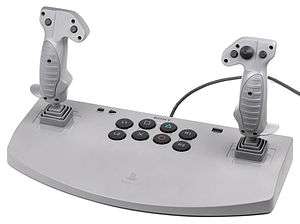PlayStation Analog Joystick
The PlayStation Analog Joystick (SCPH-1110) is Sony's first analog controller for the PlayStation, and is the precursor to the PlayStation Dual Analog Controller. It is often incorrectly[1] referred to as the "Sony Flightstick" (not to be confused with the Flightstick line of joysticks for PlayStation consoles by third-party peripheral manufacturer Hori).
 Sony's Analog Joystick (SCPH-1110) | |
| Developer | Sony Computer Entertainment |
|---|---|
| Manufacturer | Sony |
| Type | Video game controller |
| Generation | Fifth generation era |
| Release date | April 25, 1996 |
| Connectivity | PlayStation controller port |
History
Announced to the public in August 1995,[2] the Analog Joystick was released to the public in Japan in early April 1996.[3]
Features
The Analog Joystick used potentiometer technology previously used on consoles such as the Vectrex; instead of relying on binary eight-way switches, the controller can detect minute angular changes through the entire range of motion. The stick also features a thumb-operated digital hat switch on the right joystick, corresponding to the traditional D-pad, and used for instances when simple digital movements were necessary.
A compatibility mode for the Analog Joystick was included in the Dual Analog Controller, Sony's first analog revision of its original gamepad design.
PS1 games that support the PS1 Analog Joystick have an "Analog Joystick Compatible" icon on the back cover.
The Analog Joystick has a switch to select either Analog or Digital mode. When in the Digital mode, both sticks function as the gamepad on a regular PS1 controller. Older PS1 games that do not support the PS1 DualShock sticks can work with the Analog Joystick.
List of games with Analog Joystick support
PlayStation
- Ace Combat 2[4]
- Ace Combat 3[4]
- Ape Escape
- Armored Trooper Votoms (Japan)[4]
- Asteroids
- Atari Anniversary Edition Redux
- Atari Collection 2 (Paperboy, RoadBlasters, Marble Madness)[4]
- Bogey Dead 6 (Japan as Sidewinder / Europe as Raging Skies), released at the same time as the Analog Joystick [5]
- Centipede
- Car & Driver Grand Tour Racing '98[4]
- Choro Q Jet: Rainbow Wings (Japan)
- Colony Wars[4]
- Colony Wars: Vengeance[4]
- Cyberia[4]
- Descent and Descent Maximum[4]
- Digital Glider Airman (Japan)
- Elemental Gearbolt[4]
- EOS: Edge of Skyhigh (Japan)[4]
- Formula 1 97 (known as Formula 1 Championship Edition in United States and Canada)[4]
- Galaxian 3 (Japan & Europe)
- Gunship
- Independence Day
- Macross Digital Mission VF-X (Japan)
- Macross Digital Mission VF-X 2 (Japan)
- MDK
- MechWarrior 2: 31st Century Combat[4]
- Arcade's Greatest Hits: The Midway Collection 2 (used in Blaster)
- Missile Command
- Namco Museum Vol. 4 (Assault and Assault Plus only)[6][4]
- Newman / Haas Racing[4]
- Nightmare Creatures
- Pitfall 3D: Beyond the Jungle
- Project Gaiairy (Japan)[4]
- Rise 2: Resurrection[4]
- R/C Stunt Copter
- Shadow Master[4]
- Sidewinder 2[7]
- Slamscape[4]
- Steel Reign[4]
- The Need for Speed (supports digital mode only)[4]
- Treasures of the Deep
- Vehicle Cavalier (Japan)
- Vigilante 8
- Wing Commander IV: The Price of Freedom[4]
- Wing Over 2[8][9]
- Zero Pilot (Japan)
PlayStation 2
- R-Type Final (Both Analog and Digital mode)
- XG3: Extreme G Racing (Both Analog and Digital Mode)
There are other PS2 games that also can use the PS1 Analog Joystick, but only in Digital Mode. Metal Slug Anthology, Gradius III, Gradius IV and other games that normally use just the Gamepad and Buttons for controls.
Reception
GamePro's The Rat Baron praised the controller for its comfort, tight control, button layout, and analog movement, though he expressed doubt that most players would go for it given the high price tag.[10]
The PlayStation Analog Joystick did not sell well in Japan, reportedly due to its high cost and bulky size.[11]
Other
The Analog Joystick can be connected to the PC via a USB adapter and also via a DirectPad Pro style parallel port interface[12] which can be accessed under Windows using the DirectPad[13] or other drivers. The Allegro library provides the same functionality for developers.
References
- "PlayStation Developer's Guide, Version 2.5c". Sony Computer Entertainment Europe Developer Support Group. 29 May 1998. Archived from the original on 29 September 2007. Retrieved 4 April 2010.
- Gamezero.com
- Maru-Chang.com
- "Videogame Peripheral List". .Vidgames. August 16, 1998. Archived from the original on January 9, 2015.
- "Archived copy". Archived from the original on 2007-07-15. Retrieved 2007-04-20.CS1 maint: archived copy as title (link) Playstation Perfect Guide glossary
- "Review Crew: Namco Museum Volume 4". Electronic Gaming Monthly. No. 96. Ziff Davis. July 1997. p. 54.
- Box Shot of Flightstick Logo
- Box Shot of Flightstick Logo
- Box Shot of Flightstick Logo
- "Soar and Descend". GamePro. No. 91. IDG. April 1996. p. 24.
- "Touché, N64 Pad". Electronic Gaming Monthly. No. 90. Ziff Davis. January 1997. p. 20.
- Allegro library source (psxpad.c)
- Aldo's Tools
